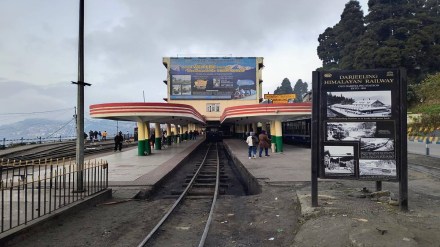“Three Ts have shaped the destiny of Darjeeling,” my tour guide told me as we get to see the first views of the hill station, driving from Siliguri. “These are tea, timber and tourism.”
These three Ts that the British discovered in the early 19th century are the reason Darjeeling got its fourth T – the train.
The next moment, we see the Darjeeling Himalayan Railway – powered by a steam engine – chugging on tracks parallel to the road. Opened in 1881, it is precursor to the Nilgiri and Kalka-Shimla railway lines, and all three lines today are UNESCO World Heritage Sites.
“These four Ts are the reason Darjeeling lies in West Bengal, and not Sikkim, even though culturally it’s close to Sikkim,” the guide said.
Why West Bengal?
According to Incredible India – the website of the Ministry of Tourism – the word ‘Darjeeling’ comes from Tibetan ‘Dorje’ meaning thunderbolt and ‘ling’ meaning land. Thus, Darjeeling means the land of the thunderbolt. It was originally part of the kingdom of Sikkim, but was acquired first by Nepal and then by the East India Company (in 1835).
By 1841, the East India Company was paying Sikkim Rs 3,000 per year for Darjeeling, which was raised to Rs 6,000 by 1846.
The British wanted Darjeeling for many reasons:
1. Entrance to eastern Himalayas and control over the trade route to Tibet;
2. Summer resort for British officials to escape the heat of the plains and Calcutta;
3. Abundant supply initially of timber and then of tea.
They constructed the Himalayan Railway (also called toy train), and changed the topography and culture of Darjeeling by cutting forests for planting tea and recruiting labourers from across India, who settled down there.
In 1947, when India gained independence, Darjeeling automatically became part of India, and Sikkim became a protectorate state. By 1975, when Sikkim became full Indian state, Darjeeling had been well-assimilated and absorbed into West Bengal.
Today’s Darjeeling
From a tourist point of view, these are the things you can do in Darjeeling, which has an old-world charm to it:
– Driving around tea plantations: All roads to Darjeeling go via tea gardens. There can be steep inclines and broken roads, but the drive is romantic anytime of the year.
– Stay in a tea estate: While there are plenty of hotels, you can live the Raj by staying at a tea estate (most offer luxury stays).
– You can visit most of the year: Summers are cool, a British ghost will tell you, and winters are freezing. But avoid the monsoon months of June-August, when rains can block roads.
– Take the train: Even if you’re driving from Siliguri, it’s a good idea to hop onto the toy train. You can enjoy the amazing views of the Himalayas and quaint villages passing by.
– Eat local: Many eateries in Darjeeling offer you food that fuses Bengali, Nepalese and Tibetan cuisines. Eat well, and wash it down with Darjeeling tea (it’s called the champagne of teas).
Does Sikkim want it?
Not really. My guide told me that despite having historical connections, Sikkim wouldn’t want it back.
“Darjeeling has a population of about 18 lakh, which is three times Sikkim’s population (about 6 lakh). If it’s included into Sikkim, greater population means development schemes may get transferred from Sikkim to Darjeeling hills, and original Sikkimese may become a minority,” the guide said. “Who in Sikkim would want that?”
High population density has made Darjeeling dirty – anywhere you go to, you will find plastic waste. “That’s an unfortunate reality of Indian tourist places,” the guide said. “The more popular it is, the dirtier it’s likely to be.”
Driving here
The nearest airport is Bagdogra (Siliguri), which has direct flights from Delhi, Kolkata, Mumbai, Bengaluru, Chennai, Ahmedabad and Hyderabad. You can easily rent a car from Siliguri. Average driving speeds are low, 25-30 km/h – due to high density of population in north Bengal, as well as narrow roads – so plan accordingly.
